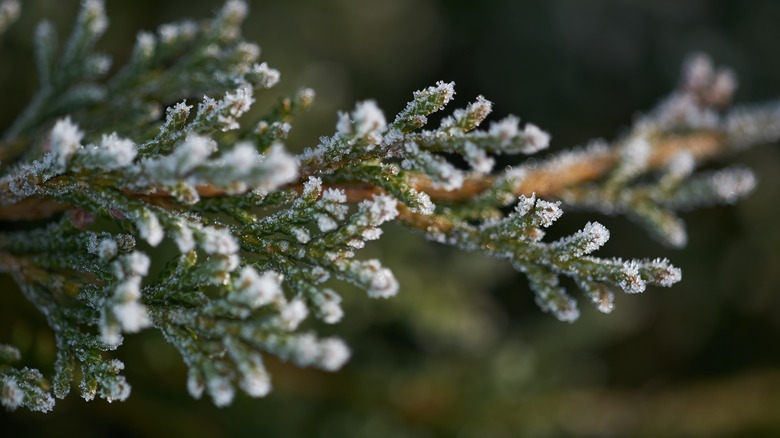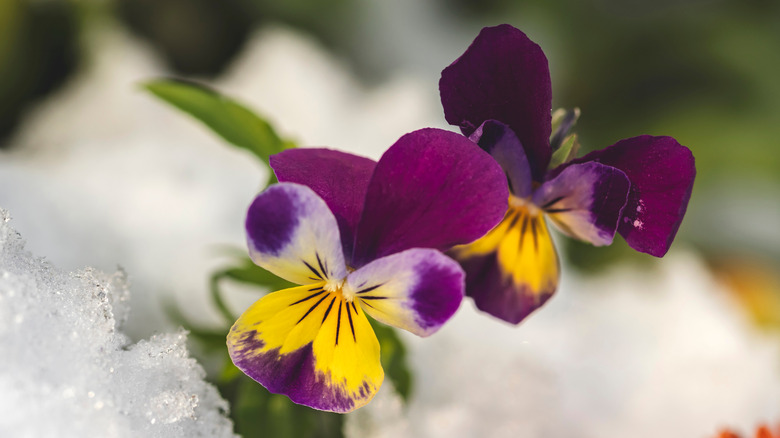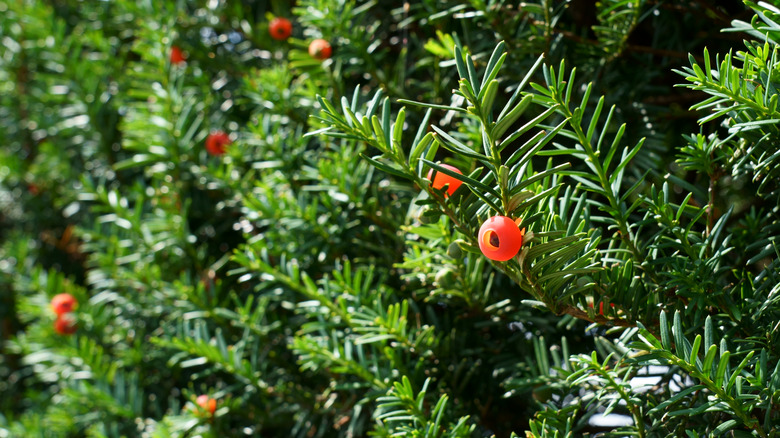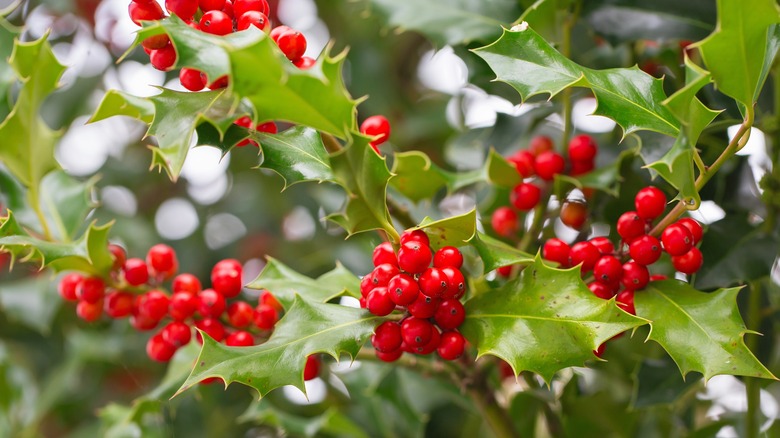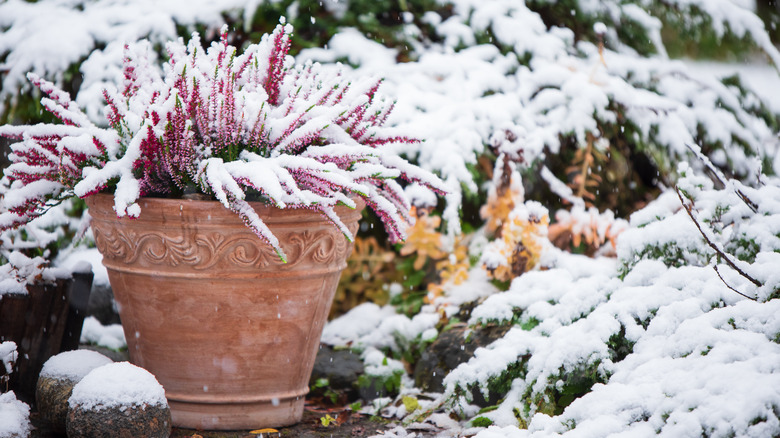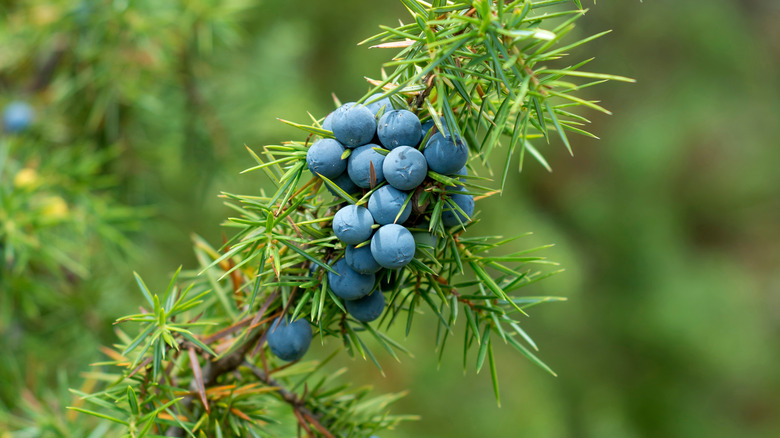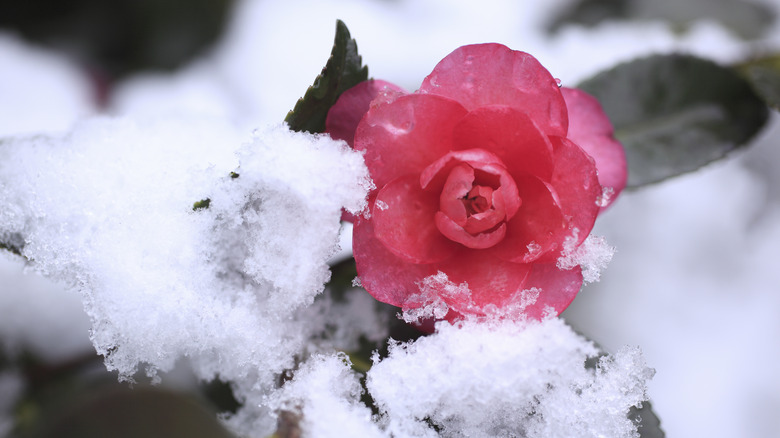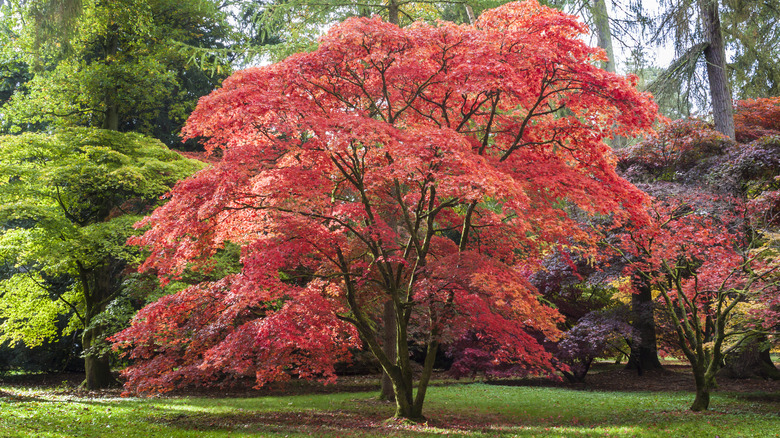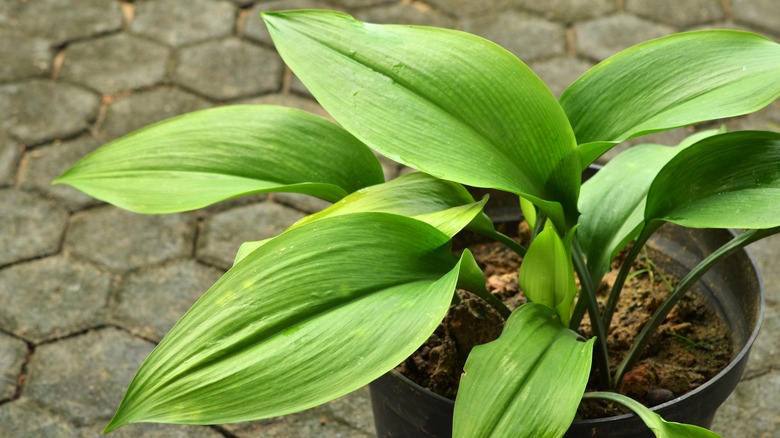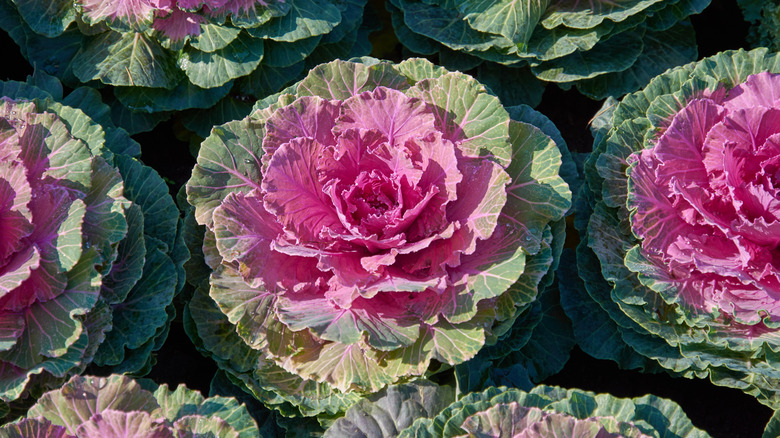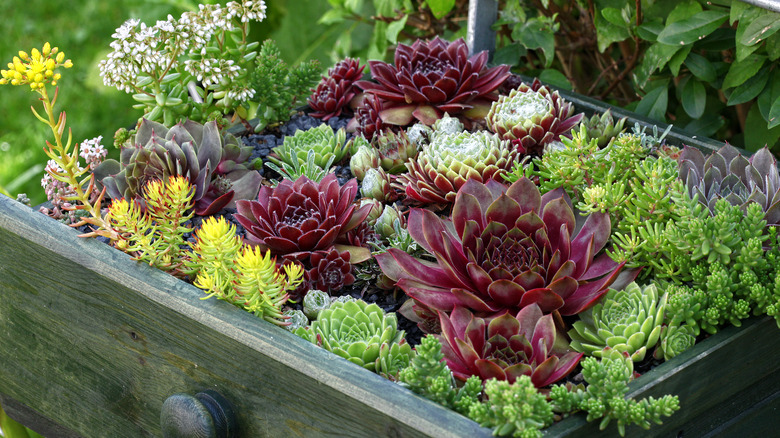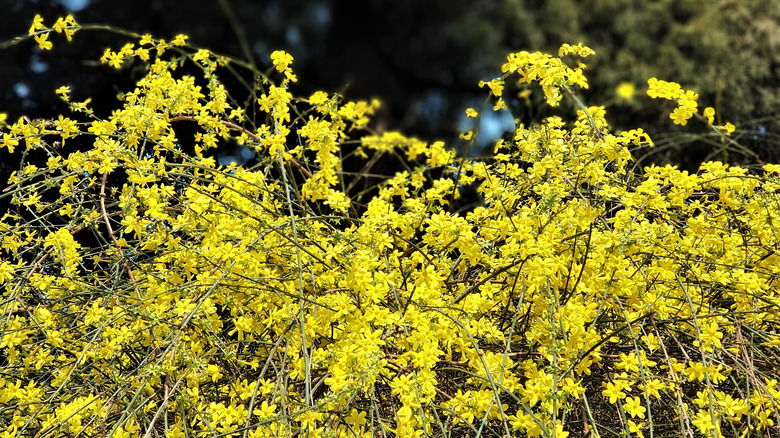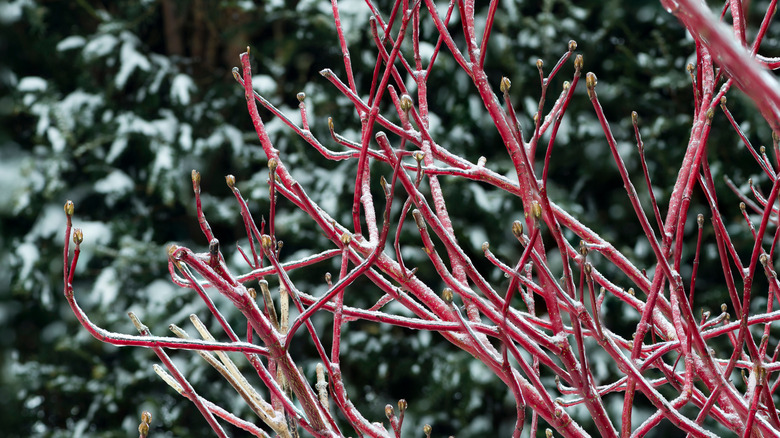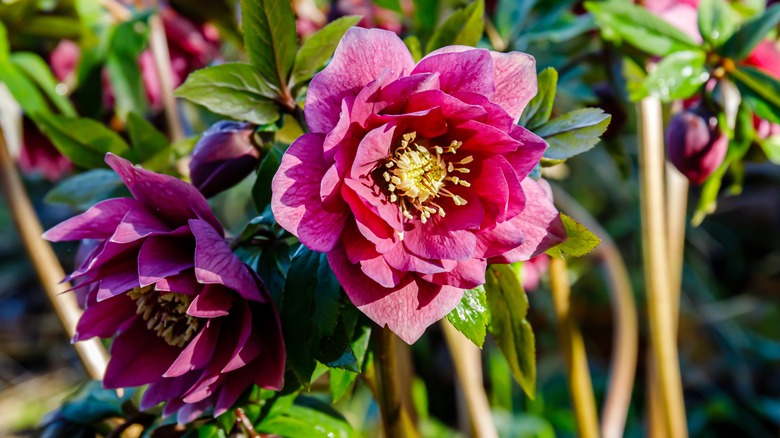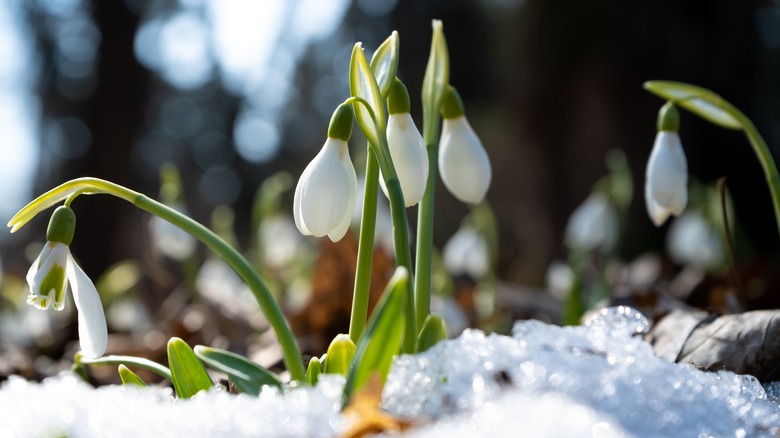Outdoor Plants That Thrive In Winter Weather
Plants can bring color and cheer to outdoor spaces during the chilly winter months. With the right plants, it's possible to have a garden that looks lovely and bright, even when the mercury drops. But how should you determine which branches and blooms suit your garden? The first step is to research your plant hardiness zone and then choose cold-weather plants from there.
The US Department of Agriculture (USDA) divides the United States into cold-hardiness zones based on the average yearly coldest temperature. This system classifies plants depending on their ability to survive in cold weather, which helps gardeners choose what plants are suitable for their area. There are 13 zones, the coldest being USDA Zone 1 (minus 60 to minus 50 degrees Fahrenheit) and the warmest USDA Zone 13 (60 to 70 degrees Fahrenheit). To start your plant search, check out the USDA Plant Hardiness Zone Map to determine your zone.
To start your winter garden, we've compiled a list of outdoor plants that do well in cold weather, including evergreens and winter-blooming perennials and annuals. Use this list as a starting point and choose plant varieties that thrive in your USDA Plant Hardiness Zone for the best results. These winter-friendly plants withstand the cold and look beautiful while doing so.
Violas
With their dainty appearance and rich colors, violas deserve a spot front and center in the garden any time of the year. According to the North Carolina State Extension, there are hundreds of species of violas, which include violets and pansies. Different types are better suited for different hardiness zones, so choose one that will flourish in your area. This task isn't too tricky: Different violas can survive in USDA Plant Hardiness Zones 1 through 10, so there are options that will survive most climates, including the very cold.
However, not all violas will bloom in all winter climates. Winter-tolerant varieties are sometimes called winter violas or winter pansies, and these can flower during mild winter periods, per Gardener's Path. Adams Fairacre Farms notes that violas thrive in cooler temperatures, between 40 and 70 degrees Fahrenheit (though they can endure brief frosts). In areas with winter temperatures in this range, they can be planted in the fall to bring much-needed winter color to a garden. Keep in mind that even if violas may not bloom all winter, they may flower during periods of mild temperatures. Violas do well in flower beds, window boxes, and planter pots, and they are best placed in easily visible areas so you can admire their beautiful color.
Japanese yew
The Japanese yew is an evergreen plant that keeps its needles year-round. Popular for its lush color and versatility as a landscaping plant, Japanese yews are excellent for a winter garden. They're an extremely cold hardy plant, suitable for USDA Plant Hardiness Zones 4 through 7, per the North Carolina State Extension.
Thriving Yard notes that Japanese yews are more cold-tolerant than many evergreen trees that survive in North America, so they're excellent for chilly climates. Even in freezing temperatures, Japanese yews will maintain their deep green, pointed needles. This yew variety does well in urban conditions, so it's a good choice for residential gardens. It's often recommended for hedging or as an accent plant, per the Morton Arboretum. Different varieties range in size from 5-foot shrubs to 40-foot trees, so there's a range of varieties for all types of landscaping purposes. In late summer into fall, the Japanese yew does develop fruit. The small red fruit resembles berries, adding a pop of color to the plant.
Holly
The deep green leaves and festive red berries of holly are synonymous with Christmas and the winter season. With its status as a seasonal icon, it's no surprise that many varieties of holly are cold hardy. The University of Illinois Extension notes that there are over 800 species of holly. To choose a suitable cultivar, look for species that thrive in your USDA Plant Hardiness Zone. According to Plant Addicts, a holly plant that is planted in a suitable hardiness zone will maintain its bright color year-round, adding festive color to a plain winter garden. Many hollies are actually at their best during fall and winter when they show off their bright red berries. Hollies will need pruning, but as an added bonus, the pruned sprigs make a festive addition to seasonal decorations.
Cold hardiness depends on the holly variety, but two types are suitable for many cold climates. Per the North Carolina State Extension, English Holly is the classic Christmas holly found in Europe. This evergreen holly also thrives in North America in zones 5 to 9. For even colder climates, consider Common Winterberry, which can thrive in zone 3.
Common heather
Common heather is hardy in zones 4 to 6, according to the North Carolina State Extension. The plant is native to Europe — picture the moorish heather fields in Scotland or Iceland, where the plant grows widely. However, common heather also can thrive in North America and can reach 2 to 3 feet tall in good growing conditions. Common heather has a low-growing and dense nature, which makes it a popular choice for ground cover, as a border plant, or to add greenery to a rock garden.
Pretty and resilient, common heather blooms with small pink, purple, or white flowers that can last into the fall, per the Missouri Botanical Garden. Once the flowers wither away, common heather doesn't lose its beauty, which makes it excellent for a winter garden. These evergreen shrubs keep their leaves year-round, making them a pretty background for other plants. The leaves often take on a purplish hue in the winter, which offers a subtle bit of color.
Juniper
Junipers are very cold hardy, with varieties thriving in USDA zones 2 through 8, per the North Carolina State Extension. They're a great plant to grow in these zones because juniper varieties are actually native to cooler areas in North America, according to the Missouri Botanical Garden. They can be found as far north as some parts of the Arctic Circle, and as far south as Minnesota and New York.
Since junipers are evergreen, meaning they maintain their leaves and appearance, even in freezing weather. These hardy plants have small, fleshy cones and needle-like leaves to form dense shrubbery. Junipers can vary in color from bluish hues to deep greens. Their cool-toned hues add some muted color to a winter landscape. Junipers hardiness and versatility make them a popular plant for landscaping. Low-growing varieties are great for ground cover or as small shrubs. Taller junipers can be planted as decorative trees, privacy hedges, or windbreaks.
Camellia
Camellias are low-maintenance and attractive shrubs, prized for their gorgeous flowers. Unlike many flowers, camellias are suitable for winter gardens because varieties can bloom all the way from fall through to spring, as per the University of Florida Extension. The flowers are usually white, pink, or red and have large petals and an eye-catching appearance. Some camellias even come in a mix of colors, with mottled white and pink petals. Camellias are evergreen shrubs. This means they look attractive even when they're not in bloom, boasting shiny, dark green leaves that are present year-round.
There are many different types of camellias, with over 2,300 named cultivars. As always, choose a variety that is suited to your USDA Plant Hardiness Zone to ensure it thrives, and consider bloom times to ensure winter color. Some cultivars bloom right in the dead of winter, such as the Winter's Rose Camellia. This camellia variety is hardy to zone 6 and blooms for up to six weeks in October and November, according to the North Carolina State Extension.
Japanese maple
Japanese maples turn a gorgeous, vibrant red color when the weather gets cooler, adding a bright pop of color to gardens. The Arbor Day Foundation specifies that Japanese maple trees thrive in hardiness zones 5 to 8. Though these trees can survive chilly winters, they are deciduous, which means they will drop their leaves eventually. However, according to Wildwood Nursery, this shedding doesn't usually happen until late November or December. This means that Japanese maples are an excellent option to bridge the gap between late fall and early winter when many other plants have long lost their flowers and leaves.
Even once a Japanese maple's leaves do shed, the vivid carpet of red they leave behind is beautiful in its own right. Since new buds can start appearing in February or March, heralding the end of winter, these trees won't be bare for long. As Wayside Gardens notes, Japanese maples make beautiful trees around a garden border or along pathways. Still, some varieties are also small enough to grow in pots or containers, making them a versatile choice for a winter garden.
Cast iron plant
In areas with milder winters, cast iron plants can provide year-round greenery. According to the University of Florida Extension, cast iron plants are hardy in zones 7 to 11. Since cast iron plants are evergreen perennials, they can maintain their attractive appearance through the winter chill — and they sure do look appealing. One of the draws of this plant is its tropical look. Cast iron plants have broad and glossy leaves, unlike many cold-tolerating evergreen plants, like Japanese yew and juniper, which have needles. The leaves are usually vibrant or deep green, adding a lush look to a garden.
Their showy appearance makes cast iron plants gorgeous decorative plants. They grow nicely in the garden or containers, and look beautiful as ground cover or in pots flanking an entryway. These tough plants even thrive in shady areas, so they'll do well on covered porches or in gardens that don't receive a lot of sunlight.
Ornamental cabbage and kale
Ornamental cabbage and kale don't have the prettiest names, but their green, purple, pink, and white foliage can make an impact in the garden. These plants are small, resembling the size of a head of cabbage. However, they have decorative, ruffled leaves that look like a large rosette, making them a welcome addition for some color and texture in gardens and plant pots.
According to the Missouri Botanical Garden, the ornamental cabbage and kale are incredibly hardy, surviving in USDA zones 2 to 11. In fact, these plants often prefer cold weather and need a cool climate to show their best colors. As Portland Nursery explains, their color tends to intensify when the temperature falls below 40 degrees Fahrenheit. Depending on the variety and the climate, some types may die off during cold winters, while in milder climates, they can last through the entire winter until the spring. The University of Wisconsin-Madison Extension notes that while many ornamental cabbages and kale are edible, they're often bitter and unpalatable, so much of these plants' value is in their looks.
Hens and chicks
Succulents are usually associated with warmer climates, but with hens and chicks, you can include them in your winter garden. According to the North Carolina State Extension, they're hardy in zones 3 to 8, making them suitable for year-round decoration in many areas. Hens and chicks make great container plants, but they're also commonly used in rock gardens, along garden borders and stone walls, and as ground cover for small areas since they are petite in size. Their fleshy leaves and rosette shape make them an appealing choice for gardeners who love succulents. Hens and chicks can come in various colors, including green, blue, purple, pink, and gray.
According to Plant Addicts, there's almost no need to protect hens and chicks over the winter as long as they're in an appropriate USDA hardiness zone. A cover of snow won't kill off these resilient plants, though they may go dormant and the outer leaves can brown in cold conditions. Even so, these plants will maintain their ornate succulent shape until they can green up again on warmer days.
Winter jasmine
Blooming in winter and early spring, winter jasmine will be the first plant to flower in many gardens, bringing some much-needed respite from the gray of winter. According to the North Carolina State Extension, winter jasmine is suitable for zones 6 to 10. During the winter months, when they're not in bloom, winter jasmine has slender green stems that still look pleasant on their own, especially when sprawled across walls or fences. But winter jasmine really shines when it flowers. This showy plant blooms around January or February, right in the middle of winter. The small yellow flowers are cheery and bright, giving this jasmine variety a sunny disposition.
Winter jasmines are a lovely decorative plant. When planted as a shrub, they grow up to 4 feet tall with arching branches in a fountain-like shape. When encouraged to grow as a vine along fences or walls, they can span areas up to 15 feet tall and 6 feet wide.
Red twig dogwood
Red twig dogwoods are a gorgeous and versatile plant that can bring color to winter gardens. Suitable for zones 3 to 7, these dogwoods boast year-round beauty for a few different reasons. Red twig dogwoods are deciduous shrubs, losing their leaves and flowers in colder seasons. However, as a winter garden plant, they're actually not prized for their foliage, but their stems. The red twig dogwood's branches look their best in the winter, turning a bright cherry red when the mercury dips. The red contrasts beautifully with the bleaker colors of wintry landscapes, particularly against the white of snow.
According to the North Carolina State Extension, new stems have the brightest winter colors, and with proper pruning, the vibrant red stems can be enjoyed year after year. However, these plants also have an ornamental element to offer year-round. Once the weather warms, they sprout deep green leaves, flower in the late spring, and develop fruit in the summer.
Hellebores
Hellebores are another flower that offers magnificent winter blooms. According to the Colorado State University Extension, hellebores come in a range of varieties, with most types showing off their winter blooms between December and April. Color options are as plentiful as bloom times, with hellebores available in white, pink, yellow, green, purple, and deep plum. Depending on the variety, hellebores are suitable to plant in zones 4 to 9.
For an early-blooming option, Swansons Nursery recommends planting the Helleborus niger cultivar, nicknamed the "Christmas Rose" because of its November blooming season that produces flowers that last until Christmas. For some later winter color, opt for the Helleborus x hybridus, nicknamed the "Lenten Rose," per the University of Wisconsin-Madison Extension. This second variety blooms in late winter, usually starting in February, to transition gardens from winter to spring. Despite the nickname, neither of these plants are roses, but are hellebore varieties.
Snowdrops
Snowdrops are small perennial flowers that are hardy in zones 3 to 9, per the North Carolina State Extension. These quaint blooms appear towards the end of winter, ushering in the first signs of spring. Depending on the climate, Home for the Harvest explains that snowdrops can start appearing as early as January in warmer areas and as late as April in chillier zones. In some climates, you'll see them pushing through the snow as a hopeful reminder of warmer weather to come. Their bloom timing at the very end of winter gives snowdrops a lot of charm.
Reminiscent of their name, snowdrops have delicate white flowers that droop downward. These flowers are small, only growing up to around 6 inches tall. However, they naturalize readily and can spread across a garden or lawn in the right conditions to create an impressive late winter display.
